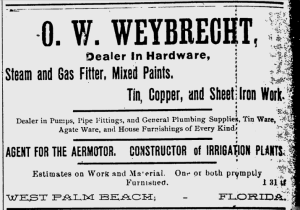It All Started with a Plumber
 Looking across the landscape of downtown West Palm Beach today, it’s hard to imagine that this entire area was once purely vacant land. And not all that long ago, historically speaking. Henry Flagler was responsible for much of our start when he rolled into town in the early 1890’s, scouting out a route for his FEC railroad. Though he had industrial progress in mind when he arrived here, he was apparently smitten enough with the natural landscape that he decided to create the Town of Palm Beach as an oasis for the rich folks up north. And, as he set out with grand plans for Palm Beach, he decided to do a little developing on the west side of the lake, as well. After all, he’d all but need a village to help him build his railroad and the fancy stuff along the ocean.
Looking across the landscape of downtown West Palm Beach today, it’s hard to imagine that this entire area was once purely vacant land. And not all that long ago, historically speaking. Henry Flagler was responsible for much of our start when he rolled into town in the early 1890’s, scouting out a route for his FEC railroad. Though he had industrial progress in mind when he arrived here, he was apparently smitten enough with the natural landscape that he decided to create the Town of Palm Beach as an oasis for the rich folks up north. And, as he set out with grand plans for Palm Beach, he decided to do a little developing on the west side of the lake, as well. After all, he’d all but need a village to help him build his railroad and the fancy stuff along the ocean.
It’s no secret that Henry Flagler is credited with having brought Palm Beach to life, but fewer people appreciate his role in plotting out a section of land that was initially deemed “Westpalmbeach.” The town’s borders were established as what is now the intracoastal waterway, west to Clear Lake, and from Althea Street down south to Fern Street. Yup, the streets were named in alphabetical order right from the get-go. . . Everything was laid out pretty much on a grid, except for two angled streets that would come off the town’s main drag, Clematis Avenue, which then was but a thin road coated with shell rock. From the very outset, that triangular section of land at the end of Clematis was designated as a public space, where picnickers might gather and the occasional baseball game would be played. That tract of land is obviously still used by and for the public today.
As things in Westpalmbeach began to take shape, folks in charge decided (thankfully) to separate the name into West Palm Beach. They did so as much for their superstitions about having a town with 13 letters as anything, but so be it. As one would expect, a local government was formed and structures began to be erected.
The very first “permanent” structure downtown was built in 1894 by a man named Otto Weybrecht, who had relocated here from the Jacksonville area. Otto built a 240 square foot building on the south side of the 200 block of Clematis, right about where Rocco’s Tacos is now. The business would become Weybrecht’s Hardware, which offered goods – much of which was tin – to the local community. Otto would also serve as the town’s first plumber. He and his family literally lived in a tent in back of the building, and they would remain there for years until the whole shootin’ match went up in flames in 1896, along with many other commercial buildings in the area. (That very same fire would lead to the creation of the first local building codes in the area, requiring that structures be built from stone or brick instead of wood.)
By the year 1900, just six years after Weybrecht’s Hardware was built, downtown West Palm Beach was abuzz with activity. Most local inhabitants were engaged in some form or another with the construction of the railroad or the resorts and upscale housing on Palm Beach. But with them all came a grocery store, a library, electricity and phone service, and water and sewer infrastructure. With each passing year of the new century, West Palm Beach transitioned from simply a support system for Palm Beach into having an identity of its own. Businesses opened, cars lined the streets, and a vibrant city was well underway.
As for Otto Weybrecht and his family, that fire of ’96 did little to dissuade them. Otto and his wife had four children, and their family presence here remained for generations. One of Otto’s sons, Willie, disabled as a child, became a local favorite as the town’s biggest baseball fan. Another, Augustus, went on to have a 38-year career as an employee of the county, and it was none other than County Commissioner Lake Lytal who offered remarks at his retirement ceremony in 1964. In fact, though I can’t say for sure, I suspect Otto’s descendants are still kicking around these parts today.
It’s hard to imagine Clematis Street being a little dirt road, but that’s exactly what it was just 120 years ago. Pretty much everyone knows that we have Henry Flagler to thank for much of what’s happened here, and he probably had the foresight to realize that his contributions would be acknowledged for centuries. Far fewer words have been written, by comparison, about Otto Weybrecht and his family, but they certainly deserve a nod for planting the very first structural seed. The folks at 610 Clematis, or Alexander Lofts, or the new Isis building going up soon, to name a few, can thank Otto’s little hardware & plumbing operation for getting the whole thing started.
(Images courtesy of the Palm Beach Post.)
